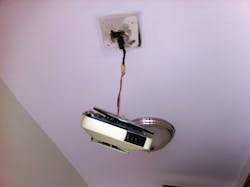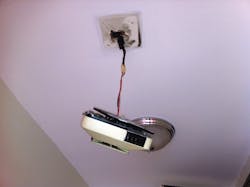How well do you know the Code? Think you can spot violations the original installer either ignored or couldn't identify? Here's your chance to moonlight as an electrical inspector and second-guess someone else's work from the safety of your living room or office. It's your turn to identify the violation.
Hint: Dangling detector
Find the Answer
The splices for this smoke detector were made with twist-on connectors and tape. However, where’s the box? This is a violation of 300.15 of the 2011 NEC.
A box or conduit body is generally required for each outlet point, switch point, termination point, and pull point or where splices are made in conduit, tubing, AC cable, MC cable, MI cable, NM cables or other cable type wiring methods. But the splices for this NM cable installation were simply stuffed into the ceiling cavity. This could have been a disaster if one of the splices came loose and started to arc and spark. The surrounding combustible wood could have easily ignited and started a fire in the attic.
Section 110.13(A) requires equipment to be firmly secured to the mounting surface. The installation instructions for the smoke detector include references for mounting the plate to a box. Since a box was not installed here, this too is a violation of the Code. Equipment must always be installed according to its instructions.
Article 760 is not applicable to this branch circuit since it is neither a Power-Limited Fire Alarm Circuit, nor a Non-Power-Limited Fire Alarm circuit as defined in 760.1. Article 210 is applicable since this is a branch circuit.
About the Author

Russ LeBlanc
Owner
Russ started in the electrical trade as an apprentice in 1985. He worked his way up to become a Journeyman Electrician and then eventually became a Master Electrician and Licensed Construction Supervisor. In 1999 Russ become an Electrical Instructor for The Peterson School of Engineering in Massachusetts where he developed his passion for teaching, and quickly became Department Head of Electrical Instruction. Russ has taught thousands of apprentices, electricians, engineers, inspectors, and other electrical professionals during his career as an instructor. He continues to provide electrical professionals with Electrical Code seminars, Arc-Flash Awareness training seminars and educational material through his LeBlanc Consulting Services in North Reading, MA whose specialty is educating electricians. He has been an active member of the NFPA Electrical Section and has authored hundreds of National Electrical Code proposals and comments which have become Code rules to improve the safety for the electrical industry. Russ is also an IAEI certified Electrical Inspector.
Please visit www.russleblanc.net for more information.

